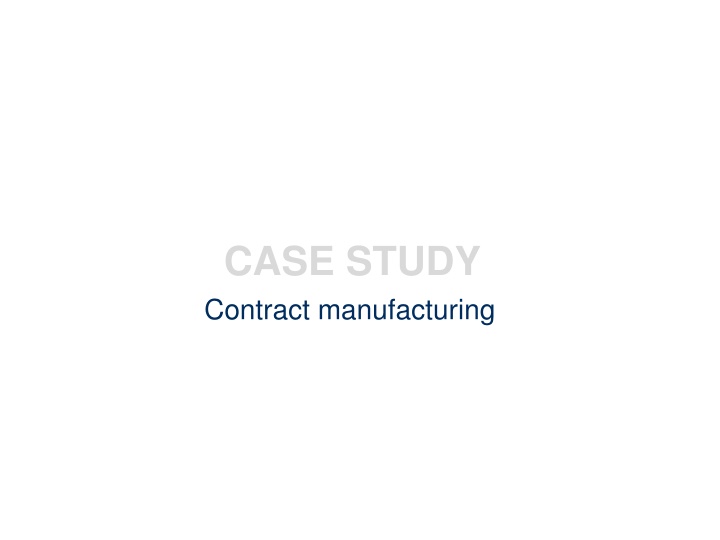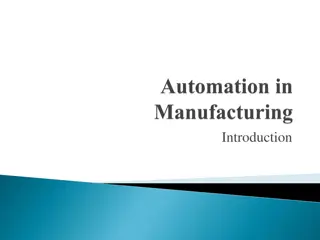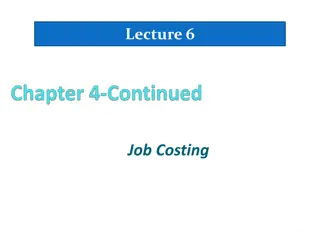Optimizing Contract Manufacturing Footprint: A Case Study
Highlighting opportunities to optimize a client's manufacturing footprint, this case study delves into the process of evaluating outsourcing options, selecting partners, and strategizing for cost efficiency and production effectiveness. By following a comprehensive approach, the case study showcases steps taken to identify and narrow down potential contract manufacturers, emphasizing the importance of vendor consolidation, cost analysis, and aligning with client objectives.
Download Presentation

Please find below an Image/Link to download the presentation.
The content on the website is provided AS IS for your information and personal use only. It may not be sold, licensed, or shared on other websites without obtaining consent from the author.If you encounter any issues during the download, it is possible that the publisher has removed the file from their server.
You are allowed to download the files provided on this website for personal or commercial use, subject to the condition that they are used lawfully. All files are the property of their respective owners.
The content on the website is provided AS IS for your information and personal use only. It may not be sold, licensed, or shared on other websites without obtaining consent from the author.
E N D
Presentation Transcript
CASE STUDY Contract manufacturing
Our initial operational diagnostic highlighted opportunities to optimize our client s footprint Project drivers: Most products have long lifecycles with commoditized manufacturing process Footprint should reflect lowest global labour and overheard rates Product components are commodities Component spend is the largest cost element of production Vendor consolidation will drive downward price pressure through volume Major questions: How much, and what, should we outsource? Who should our outsource partners be? Are we realizing the benefits of the vendors we have and the regions in which they manufacture? For Satov Consultants Inc. (Satov) clients only; No portion of this presentation is to be distributed to other parties without prior express written consent from Satov distributed to other parties without prior express written consent from Satov For Satov Consultants Inc. (Satov) clients only; No portion of this presentation is to be 2
We followed a comprehensive process to evaluate the firm s footprint options Initiate external quotes and analyses Conduct internal analysis Formulate strategy Synthesize Evaluate internal costs to develop RFI / RFP cost expectations Identify alternate vendors Evaluate all RFP responses Articulate future state of current facilities including scope of production, consolidation options, etc. Evaluate new product introduction (NPI) capabilities for each potential vendor Quote out sample product line packages Analyze overhead cost take-out opportunities as production is outsourced Identify component spend consolidation opportunities and conduct RFP Articulate target production destination by SKU Create consolidated scenario models based on all internal and RFI / RFP data Calculate one time costs of workforce reductions Investigate potential for government incentives to remain in the United States Articulate distribution network / strategy Integrate with Lean as necessary Develop high level implementation plan and timeline Model potential distribution configurations and freight spend Developed detailed business case for implementation Evaluate real estate and other asset sale potential For Satov Consultants Inc. (Satov) clients only; No portion of this presentation is to be distributed to other parties without prior express written consent from Satov 3
We used several steps to identify and narrow the field of potential contract manufacturers Large pool (n=100) High level screen based on footprint and size(n=30) Other criteria including footprint, direct fulfillment and stability(n=20) Detailed evaluation based on informal RFIs, interviews, SATOV experience and 3rd party research (n=9) RFP Candidates (n=4 +incumbents) Evaluation Final footprint network For Satov Consultants Inc. (Satov) clients only; No portion of this presentation is to be distributed to other parties without prior express written consent from Satov 4
We evaluated potential contract manufacturers based on several criteria Technical Capabilities Overall Score EMS Supplier Revenue Footprint Distribution Stability Focus NPI Comments CM 1 4 4 Yes 4 5 5 4 4.33 Heavily focused on xyz industry CM 2 3 4.5 Yes 5 4 4 4 4.08 Focused on xyz industry CM 3 2 5 Yes 4 4 5 4 4 Large, but broken down based on segments, regions CM 4 3 4.5 Yes 4 3.5 4.5 4 3.91 Focus on abc and xyc industries Good footprint. Some question of complexity capabilities CM 5 3.5 4 Yes 3 4 3.5 5 3.83 Ideal size and capabilities. Limited footprint beyond US & Mexico CM 6 4 3 Yes 4 3 4 4 3.83 CM 7 1 5 Yes 4 4 5 4 3.83 Tier 1 but has strategy of pursuing smaller customers 3 3 Yes 4 3 3.5 4 3.4 Mexican manufacturing located in preferable region CM 8 Good focus on xyz industry. Some questions about footprint CM 9 3 3 Yes 4 3 3.5 4 3.3 CM 10 3.5 3.5 Yes 1 3 4 4 3.16 Poor financial health CM 11 3 2 Yes 3.5 2 4.5 3.5 3.08 EMS focused on xyz CM 12 3 3 Yes 2 2 3 4 2.83 Customer concentration, xyz industry focus CM 13 3 4 No ? 3 3 3 2.66 Poor distribution capabilities CM 14 4 2 No ? 3 3 1 2.16 Poor distribution capabilities CM 15 3 2 Yes ? ? ? ? 0 Unreachable CM 16 4 3 Yes ? ? ? ? 0 Unreachable Positive Neutral Negative For Satov Consultants Inc. (Satov) clients only; No portion of this presentation is to be distributed to other parties without prior express written consent from Satov distributed to other parties without prior express written consent from Satov For Satov Consultants Inc. (Satov) clients only; No portion of this presentation is to be 5
The RFP process had several objectives Which suppliers have the best capabilities? Which suppliers offer us the best potential for savings? Should we continue working with current partners or new ones? Pick the best suppliers Reduce costs from existing suppliers Use RFP for leverage with current suppliers Use RFP to get ongoing cost reduction commitments Determine whether to outsource What would be the total cost to outsource existing production? Engage suppliers in a more sophisticated partnership Gauge supplier interest and capabilities in key areas: co-investing in Lean improvements, PPV sharing, cost reduction over time, NPI 6
We quoted out a representative sample of the SKU portfolio for vendors to bid Component Product Type Component Product Type 20-xxx-0001 50000001-xx 20-xxx-0002 50000002-xx 20-xxx-0003 50000003-xx Product line A Product line F 20-xxx-0004 50000004-xx 20-xxx-0005 50000005-xx 20-xxx-0006 50000006-xx 20-xxx-0007 Product line B Product line G 50000007-xx 20-xxx-0008 50000008-xx 50000009-xx 20-xxx-0009 50000010-xx 20-xxx-0010 50000011-xx Product line C Product line H 20-xxx-0011 50000012-xx 20-xxx-0012 50000013-xx 20-xxx-0013 50000014-xx Product line D Product line I 20-xxx-0014 50000015-xx Product line E Product line J 50000016-xx 20-xxx-0015 For Satov Consultants Inc. (Satov) clients only; No portion of this presentation is to be distributed to other parties without prior express written consent from Satov distributed to other parties without prior express written consent from Satov For Satov Consultants Inc. (Satov) clients only; No portion of this presentation is to be 7
Each supplier was evaluated on a comprehensive, prioritized list of criteria Capability Profile and financials Manufacturing and quality Technical Capabilities: General Technical Capabilities: Product line Planning NPI Distribution (direct to customer) General pricing and terms Product line pricing Total response rating Timeliness bonus Engagement & trust bonus Weight 12 15 10 5 10 8 2 10 28 100 10 10 The weightings were based on the firm s priorities There are thresholds within each category that can rule out a player regardless of aggregate score Scenario modeling will be based on the lowest cost player and the best overall score We will not select solutions which raise our costs from current state For Satov Consultants Inc. (Satov) clients only; No portion of this presentation is to be distributed to other parties without prior express written consent from Satov distributed to other parties without prior express written consent from Satov For Satov Consultants Inc. (Satov) clients only; No portion of this presentation is to be 8
We negotiated lower prices from the current vendors Incumbent vendor currently producing products quoted in the RFP* Quote as % of Current Price Quoted product Current Price Quoted Price Product 1 Product 2 Product 3 Product 4 Product 5 Product 6 Product 7 $100.00 $25.00 $20.00 $80.00 $25.00 $175.00 $155.00 $95.00 $23.00 $18.00 $73.00 $22.00 $175.00 $150.00 95% 93% 92% 91% 89% 100% 98% Current vendor A 80% / 93% Product A $35.00 $30.00 Product B Product C Product D $16.00 $19.00 $28.00 $14.00 $16.00 $25.00 83% / 91% 83% / 88% 86% / 96% Current vendor B 103% Product E $9.00 $10.00 102% Product F $50.00 $51.00 94% Product ABC $64.00 $61.00 Current vendor C Product XYZ $88.00 $85.00 96% The RFP process will drive cost savings even if no new suppliers are selected The new pricing is however based on larger volume expectations (can t count on all of if we don t consolidate the supplier base and outsource more For Satov Consultants Inc. (Satov) clients only; No portion of this presentation is to be distributed to other parties without prior express written consent from Satov 9
Supplier evaluation summary RFP process observations (timing, engagement, etc.) Supplier High level supplier summary (pricing, capabilities, other observations) On time with all inputs Reliable, flexible supplier and has full management attention Pricing generally less advantageous than Asian suppliers Small company with less capabilities than the others Vendor A Pro-active in understanding RFP and working with our firm Reliable current supplier Less flexible and with less ability to deal with demand volatility but indicated willingness to work with our firm to implement Lean May be understaffed in some key areas Best pricing driven by labor cost and favorable profit model Late with responses / had to rework some elements of the quote Vendor B Poor communication but improved after a strongly worded communication Generally good engagement and compliance with timelines Vendor C Good capabilities and competitive pricing Best capabilities (as expected) High pricing, driven to a large extent by high profit and overhead charges Expectation of best material pricing (scale buying) not demonstrated On time with all inputs Vendor D Very engaged and responsive Struggled to complete all inputs on time Strong capabilities and very competitive pricing driven primarily by low labor cost Pricing of higher volume SKUs more favorable than lower volume (relative to competitors) Strong contender to become the strategic back-up to vendor A Need for due diligence on capabilities and pricing (ability to handle low volume SKUs and demand volatility are the biggest concerns), including site visit Very engaged throughout Vendor E Tried to manage timing by communication and phased submissions For Satov Consultants Inc. (Satov) clients only; No portion of this presentation is to be distributed to other parties without prior express written consent from Satov distributed to other parties without prior express written consent from Satov For Satov Consultants Inc. (Satov) clients only; No portion of this presentation is to be 10
We modeled financial impacts by rebuilding the firms COGS using the new price inputs from the RFP Model Impact COGS As a result of new outsourcing, facility costs were scaled back as operations wound down Manufacturing Expenses: Facility, Tooling, Depreciation, etc. As a result of new outsourcing, facility costs were scaled back as operations wound down Labour: Direct & Indirect SKU component costs were re-priced using new pricing inputs from the RFP analysis Variable Costs: Material cost by SKU The zero cost model reflected the transition of fixed costs (labour, facility, etc.) to variable through increased outsourcing activity For Satov Consultants Inc. (Satov) clients only; No portion of this presentation is to be distributed to other parties without prior express written consent from Satov distributed to other parties without prior express written consent from Satov For Satov Consultants Inc. (Satov) clients only; No portion of this presentation is to be 11
We developed a list of potential scenarios to compare to the firm s projected status quo for 20xx 20xx Status Quo Scenario 1: Consolidate Suppliers Scenario 2: Scenario 3: Consolidate Suppliers Outsource all non- configurable and NPI volume Consolidate Suppliers Outsource all production Status Quo Status Quo Marginal increase Complete Degree Outsourced No new pricing input Yes No Yes Yes New pricing? Yes No Yes Yes Footprint change? No No Yes: Yes Cost takeout opportunity 20xx budget Headcount All direct labor Facility All direct manufacturing facility Final COGS We compared total COGs for each scenario to find optimal mix For Satov Consultants Inc. (Satov) clients only; No portion of this presentation is to be distributed to other parties without prior express written consent from Satov distributed to other parties without prior express written consent from Satov For Satov Consultants Inc. (Satov) clients only; No portion of this presentation is to be 12
We recommended a footprint strategy The big questions The recommendations The reasons Retain only NPI production in the near term How much, and what, should we outsource? Aim to outsource all production in the long term (5+ years) Should we produce anything at Facility B? No: move NPI to Location A and outsource the rest Consolidate most production with Vendor A and Vendor B in the near term Who should our outsource partners be? Build up vendor D as back up Asian supplier Aim to transition out of Vendor C within 3-5 years Should we outsource distribution? No Should we change distribution locations? No Should we consolidate operations in W76 Yes For Satov Consultants Inc. (Satov) clients only; No portion of this presentation is to be distributed to other parties without prior express written consent from Satov distributed to other parties without prior express written consent from Satov For Satov Consultants Inc. (Satov) clients only; No portion of this presentation is to be 13























